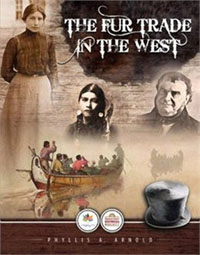| ________________
CM . . .
. Volume XXIII Number 28. . . .March 31, 2017
excerpt:
Published by the Edmonton and District Historical Society for Canada 150, The Fur Trade in the West, a nonfiction book for elementary school readers, is about the partnerships French and British fur traders made with the First Nations in Canada. Trading beaver pelts eventually led to the discovery and settlement of Western Canada. The book is divided into six parts beginning with why beaver pelts were so valuable to Europeans. Part two details the development of the Hudsonís Bay Company and the North West Company. The author explains how people, such as French traders Pierre-Esprit Radisson and Mťdard Chouart, Henry Kelsey, Anthony Henday, Peter Pond, and the First Nations, helped this industry get its start. This chapter also discusses the problems the traders faced, such as war over the control of settlement and trade, the illegal trading that went on between 1731-1743 in Rupertís Land, and how smallpox killed a large number of First Nation middlemen and thus decreased access to the fur-trading networks. Section three is about the expansion of the fur trade on the Saskatchewan River System. Alexander Mackenzie, Captain James Cook, and Simon Fraser are explorers mentioned in section four. There is a description of what voyageurs endured when transporting furs by canoe along the rivers. Part five is about settlers along the Red River and the troubles they faced, as well as the merging of the Hudsonís Bay Company and the North West Company in 1821. Fort Edmonton is highlighted in this section with photographs from 1914 and historical and present day views of the area. The final chapter is about Confederation, Canadaís 150th birthday, and the changes that resulted from settlement, such as the establishment of the North West Mounted Police, the seven treaties the government of Canada signed with the First Nations living in the North-West Territories, the completion of the Canadian Pacific Railway, and the creation of homesteads on free land. Back material consists of a two page glossary, answers to the questions, an extensive index, and a chart of First Nation Peoples historic names and preferred names today. The information the author provides is interesting, and itís presented in a clear, logical way. With its numerous labelled maps, charts, illustrations, photographs and factual narratives, The Fur Trade in the West will be useful for in-depth school projects and assignments. Highly Recommended. Tanya Boudreau is a librarian at the Cold Lake Public Library in Cold Lake, AB.
To comment
on this title or this review, send mail to cm@umanitoba.ca.
Copyright © the Manitoba Library Association. Reproduction for personal
use is permitted only if this copyright notice is maintained. Any
other reproduction is prohibited without permission.
Next Review | Table of Contents For This Issue - March 31, 2017 |
